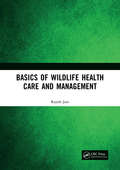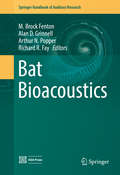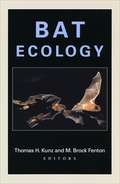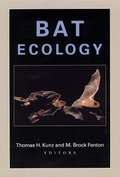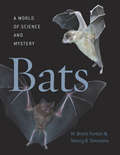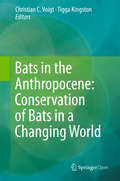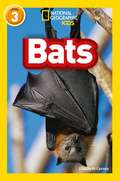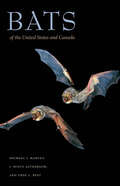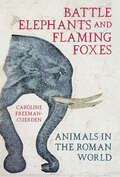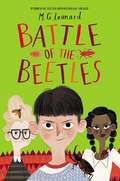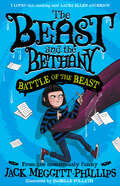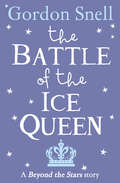- Table View
- List View
Basics of Wildlife Health Care and Management
by Rajesh JaniThe book provides basic understanding of the various topics of wildlife which will be useful for biologist, zoologist, veterinarians working in forest ,zoos or at field level where they use to get wild animals for post mortem or for treatment. It also provides helpful information to the forest officers, zoo managers and protected area managers for critical care management and for doing needful things before approaching a veterinarian to save the life of animal or to collect biological material useful for diagnosis. Note: T&F does not sell or distribute the Hardback in India, Pakistan, Nepal, Bhutan, Bangladesh and Sri Lanka.
Basics of Wildlife Health Care and Management
by Rajesh JaniThe book provides basic understanding of the various topics of wildlife which will be useful for biologist, zoologist, veterinarians working in forest ,zoos or at field level where they use to get wild animals for post mortem or for treatment. It also provides helpful information to the forest officers, zoo managers and protected area managers for critical care management and for doing needful things before approaching a veterinarian to save the life of animal or to collect biological material useful for diagnosis. Note: T&F does not sell or distribute the Hardback in India, Pakistan, Nepal, Bhutan, Bangladesh and Sri Lanka.
Bat Bioacoustics (Springer Handbook of Auditory Research #54)
by M. Brock Fenton Alan D Grinnell Arthur N. Popper Richard R. FayArguably biosonar is one of the ‘eye-opening’ discoveries about animal behavior and the auditory systems of echolocators are front and center in this story. Echolocation by bats has proven to be a virtual gold mine for colleagues studying neurobiology, while providing many rich examples of its impact on other areas of bats’ lives. In this volume we briefly review the history of the topic (reminding readers of the 1995 Hearing by Bats). We use a chapter on new findings in the phylogeny of bats to put the information that follows in an evolutionary context. This includes an examination of the possible roles of Prestin and FoxP2 genes and various anatomical features affecting bat vocalizations. We introduce recent work on the role of noseleafs, ears, and other facial components on the focusing of sound and collection of echoes.
Bat Ecology
by Thomas H. Kunz M. Brock FentonIn recent years researchers have discovered that bats play key roles in many ecosystems as insect predators, seed dispersers, and pollinators. Bats also display astonishing ecological and evolutionary diversity and serve as important models for studies of a wide variety of topics, including food webs, biogeography, and emerging diseases. In Bat Ecology, world-renowned bat scholars present an up-to-date, comprehensive, and authoritative review of this ongoing research. The first part of the book covers the life history and behavioral ecology of bats, from migration to sperm competition and natural selection. The next section focuses on functional ecology, including ecomorphology, feeding, and physiology. In the third section, contributors explore macroecological issues such as the evolution of ecological diversity, range size, and infectious diseases (including rabies) in bats. A final chapter discusses conservation challenges facing these fascinating flying mammals. Bat Ecology is the most comprehensive state-of-the-field collection for scientists and researchers. Contributors: John D. Altringham, Robert M. R. Barclay, Tenley M. Conway, Elizabeth R. Dumont, Peggy Eby, Abigail C. Entwistle, Theodore H. Fleming, Patricia W. Freeman, Lawrence D. Harder, Gareth Jones, Linda F. Lumsden, Gary F. McCracken, Sharon L. Messenger, Bruce D. Patterson, Paul A. Racey, Jens Rydell, Charles E. Rupprecht, Nancy B. Simmons, Jean S. Smith, John R. Speakman, Richard D. Stevens, Elizabeth F. Stockwell, Sharon M. Swartz, Donald W. Thomas, Otto von Helversen, Gerald S. Wilkinson, Michael R. Willig, York Winter
Bat Ecology (PDF)
by Thomas H. Kunz M. Brock FentonBats display astonishing ecological and evolutionary diversity and serve as important models for studies of a wide variety of topics, including food webs, biogeography, and emerging diseases. In "Bat Ecology", world-renowned bat scholars present an up-to-date, comprehensive, and authoritative review of this ongoing research. The first part of the book covers the life history and behavioral ecology of bats, from migration to sperm competition and natural selection. The next section focuses on functional ecology, including ecomorphology, feeding, and physiology. In the third section, contributors explore macroecological issues such as the evolution of ecological diversity, range size, and infectious diseases (including rabies) in bats. A final chapter discusses conservation challenges facing these fascinating flying mammals.
Batpants!
by Jeremy StrongBATPANTS the orang-utan is completely, wildly HAIRY. She loves swinging through trees, and apple crumble and roast chicken. But most of all she loves her family, the Loveharts, and all their madcap adventures.Mrs Lovehart is a stuntwoman and so the whole family is off to watch her in action in her latest film. But someone on set has an eeeevil plan and things could turn nasty - will it be Batpants to the rescue?
Batpants and the Vanishing Elephant
by Jeremy StrongFANTASTI-BUBBLY-CRUMBO!When the Lovehart family receive a MEGA-MASSIVE delivery, there's only one thing it can be. An elephant of course! A gentle giant named Fudge has come to live with them - he can be a friend for their pet orang-utan, Batpants. But then Fudge mysteriously vanishes . . . he's been elephant-napped, for a ransom of TWO MILLION pounds!Who can save twinkle-toes Fudge? Never fear - Batpants is on the trail!Hoo hooo hooooo ha ha ha ha ha!
Bats: From Evolution to Conservation
by John D. AltringhamBats are highly charismatic and popular animals that are not only fascinating in their own right, but illustrate most of the topical and important concepts and issues in mammalian biology. This book covers the key aspects of bat biology, including evolution, flight, echolocation, hibernation, reproduction, feeding and roosting ecology, social behaviour, migration, population and community ecology, biogeography, and conservation. This new edition is fully updated and greatly expanded throughout, maintaining the depth and scientific rigour of the first edition. It is written with infectious enthusiasm, and beautifully illustrated with drawings and colour photographs.
Bats: In a World of Echoes
by Johan Eklöf Jens RydellThis comprehensive book about the lives of bats is about a group of peculiar, mythical and fascinating animals. They are mammals, just like us, but still so different. The book covers bats from Latin American Maya temples to Swedish potato cellars; from the plains of Kenya to the Taiwanese mountains.We perceive their shadows flitting by in the summer nights, hear their mating calls in the darkness of autumn and see their silhouettes in the dim street light. The bats live in our houses and forage in our gardens and parks. But who are they and how do they lead their lives?The text and exquisite photos give an unsurpassed insight into the world of sounds and smells that bats encounter each night. We are told about how their senses, way beyond our human perception abilities, shape their lives. We get to know more about their habits, their long evolution and their cohabitation with humans, and how important they are to the environment.You will never again feel lonely in the darkness of the night.
Bats: A World of Science and Mystery
by M. Brock Fenton Nancy B. SimmonsThere are more than 1,300 species of bats—or almost a quarter of the world’s mammal species. But before you shrink in fear from these furry “creatures of the night,” consider the bat’s fundamental role in our ecosystem. A single brown bat can eat several thousand insects in a night. Bats also pollinate and disperse the seeds for many of the plants we love, from bananas to mangoes and figs. Bats: A World of Science and Mystery presents these fascinating nocturnal creatures in a new light. Lush, full-color photographs portray bats in flight, feeding, and mating in views that show them in exceptional detail. The photos also take the reader into the roosts of bats, from caves and mines to the tents some bats build out of leaves. A comprehensive guide to what scientists know about the world of bats, the book begins with a look at bats’ origins and evolution. The book goes on to address a host of questions related to flight, diet, habitat, reproduction, and social structure: Why do some bats live alone and others in large colonies? When do bats reproduce and care for their young? How has the ability to fly—unique among mammals—influenced bats’ mating behavior? A chapter on biosonar, or echolocation, takes readers through the system of high-pitched calls bats emit to navigate and catch prey. More than half of the world’s bat species are either in decline or already considered endangered, and the book concludes with suggestions for what we can do to protect these species for future generations to benefit from and enjoy. From the tiny “bumblebee bat”—the world’s smallest mammal—to the Giant Golden-Crowned Flying Fox, whose wingspan exceeds five feet, A Battery of Bats presents a panoramic view of one of the world’s most fascinating yet least-understood species.
Bats: A World of Science and Mystery
by M. Brock Fenton Nancy B. SimmonsThere are more than 1,300 species of bats—or almost a quarter of the world’s mammal species. But before you shrink in fear from these furry “creatures of the night,” consider the bat’s fundamental role in our ecosystem. A single brown bat can eat several thousand insects in a night. Bats also pollinate and disperse the seeds for many of the plants we love, from bananas to mangoes and figs. Bats: A World of Science and Mystery presents these fascinating nocturnal creatures in a new light. Lush, full-color photographs portray bats in flight, feeding, and mating in views that show them in exceptional detail. The photos also take the reader into the roosts of bats, from caves and mines to the tents some bats build out of leaves. A comprehensive guide to what scientists know about the world of bats, the book begins with a look at bats’ origins and evolution. The book goes on to address a host of questions related to flight, diet, habitat, reproduction, and social structure: Why do some bats live alone and others in large colonies? When do bats reproduce and care for their young? How has the ability to fly—unique among mammals—influenced bats’ mating behavior? A chapter on biosonar, or echolocation, takes readers through the system of high-pitched calls bats emit to navigate and catch prey. More than half of the world’s bat species are either in decline or already considered endangered, and the book concludes with suggestions for what we can do to protect these species for future generations to benefit from and enjoy. From the tiny “bumblebee bat”—the world’s smallest mammal—to the Giant Golden-Crowned Flying Fox, whose wingspan exceeds five feet, A Battery of Bats presents a panoramic view of one of the world’s most fascinating yet least-understood species.
Bats in the Anthropocene: Conservation of Bats in a Changing World
by Christian C. Voigt Tigga KingstonThis book focuses on central themes related to the conservation of bats. It details their response to land-use change and management practices, intensified urbanization and roost disturbance and loss. Increasing interactions between humans and bats as a result of hunting, disease relationships, occupation of human dwellings, and conflict over fruit crops are explored in depth. Finally, contributors highlight the roles that taxonomy, conservation networks and conservation psychology have to play in conserving this imperilled but vital taxon.With over 1300 species, bats are the second largest order of mammals, yet as the Anthropocene dawns, bat populations around the world are in decline. Greater understanding of the anthropogenic drivers of this decline and exploration of possible mitigation measures are urgently needed if we are to retain global bat diversity in the coming decades. This book brings together teams of international experts to provide a global review of current understanding and recommend directions for future research and mitigation.
Bats: Level 3 (National Geographic Readers Ser.)
by Elizabeth Carney National Geographic Kids StaffNational Geographic Primary Readers pair magnificent National Geographic photographs with engaging text by skilled authors to help your child learn to read. Developed by education experts, this series of books for beginner readers is spread across four levels: Early Reader, Becoming Fluent, Becoming Independent and Independent Reader. They live in spooky caves, in forests, and even in the dark reaches of ordinary attics and bridges. They flock by the hundreds, and they sleep while hanging upside down! In this beautifully photographed National Geographic Kids Level 3 Reader, children will learn about one of the world’s most intriguing creatures and discover the bat’s unique place in the wild. Level 3: Becoming Independent books are best suited for kids who are ready for complex sentences and more challenging vocabulary, but still draw on occasional support from adults. They are ideal for readers of Purple and Gold book bands for guided reading.
Bats of Britain and Europe
by Christian Dietz Andreas KieferThis concise and definitive guide presents all 45 bat species that regularly occur in Europe (of which 17 are known to breed in the British Isles). The extensive introduction details the remarkable biology of bats and explores the latest findings in bat evolution, behaviour and echolocation.This is followed by in-depth species accounts covering life history, conservation status and identification, including echolocation characteristics, and complemented by accurate distribution maps, with the book illustrated throughout with superb colour photography.Suitable for beginners, students, professionals or conservationists alike, Bats of Britain and Europe is the authoritative field guide for bat watchers – an essential reference for every bat enthusiast.- Allows identification of families, genera and where possible species of all European bats- Illustrated throughout with almost 700 colour photographs- Packed with information on bat behaviour, ecology and conservation
Bats of Britain and Europe
by Christian Dietz Andreas KieferThis concise and definitive guide presents all 45 bat species that regularly occur in Europe (of which 17 are known to breed in the British Isles). The extensive introduction details the remarkable biology of bats and explores the latest findings in bat evolution, behaviour and echolocation.This is followed by in-depth species accounts covering life history, conservation status and identification, including echolocation characteristics, and complemented by accurate distribution maps, with the book illustrated throughout with superb colour photography.Suitable for beginners, students, professionals or conservationists alike, Bats of Britain and Europe is the authoritative field guide for bat watchers – an essential reference for every bat enthusiast.- Allows identification of families, genera and where possible species of all European bats- Illustrated throughout with almost 700 colour photographs- Packed with information on bat behaviour, ecology and conservation
Bats of the United States and Canada
by Michael J. Harvey J. Scott Altenbach Troy L. BestThe only mammals capable of true flight, bats are among the world’s most fascinating creatures. This accessible guide to the forty-seven species of bats found in the United States and Canada captures and explains the amazing diversity of these marvels of evolution.A wide variety of bat species live in the United States and Canada, ranging from the California leaf-nosed bat to the Florida bonneted bat, from the eastern small-footed bat to the northern long-eared bat. The authors provide an overview of bat classification, biology, feeding behavior, habitats, migration, and reproduction. They discuss the ever-increasing danger bats face from destruction of habitat, wind turbines, chemical toxicants, and devastating diseases like white-nose syndrome, which is killing millions of cave bats in North America. Illustrated species accounts include range maps and useful identification tips. Written by three of the world’s leading bat experts and featuring J. Scott Altenbach's stunning photographs, this fact-filled and easy-to-use book is the most comprehensive and up-to-date account of bats in the U.S. and Canada.
Bats of the United States and Canada
by Michael J. Harvey J. Scott Altenbach Troy L. BestThe only mammals capable of true flight, bats are among the world’s most fascinating creatures. This accessible guide to the forty-seven species of bats found in the United States and Canada captures and explains the amazing diversity of these marvels of evolution.A wide variety of bat species live in the United States and Canada, ranging from the California leaf-nosed bat to the Florida bonneted bat, from the eastern small-footed bat to the northern long-eared bat. The authors provide an overview of bat classification, biology, feeding behavior, habitats, migration, and reproduction. They discuss the ever-increasing danger bats face from destruction of habitat, wind turbines, chemical toxicants, and devastating diseases like white-nose syndrome, which is killing millions of cave bats in North America. Illustrated species accounts include range maps and useful identification tips. Written by three of the world’s leading bat experts and featuring J. Scott Altenbach's stunning photographs, this fact-filled and easy-to-use book is the most comprehensive and up-to-date account of bats in the U.S. and Canada.
Bats Sing, Mice Giggle: The Surprising Science of Animals' Inner Lives
by Karen Shanor Jagmeet Kanwal"Bats Sing, Mice Giggle" tracks many years of research by hundreds of scientists that reveals how wild animals, as well as pets, have inner, secret lives of which until recently - although many animal lovers will have instinctively believed it - we have had little proof. The authors show how animal 'friends' stay in touch, and how they warn and help each other in times of danger; how some animals problem-solve as or in some instances even more effectively than humans - and how they regulate, create, and entertain themselves and others. They show how animals express grief and reverence in ways we never thought possible. From the sleep patterns of some owls, birds and horses, as well as porpoises, who go to sleep in only one half of their brains at a time; to how schools of electric fish give off complex signals of one frequency to communicate with their mates and another frequency to locate their prey, and how Polar bears tune into quantum 'radio stations' to sense prey as far away as ten miles and under the snow, "Bats Sing, Mice Giggle" provides an unparalleled insight into animals' secret lives.
The Battersea Dogs and Cats Home: Choosing The Right Dog For You
by Gwen BaileyThe world's oldest and most famous cat and dog home has teamed up with the UK bestselling pet behaviourist to bring you the ultimate guide to choosing the right dog for you and your family.There are over 200 breeds profiled, with details of each dog's temperament, physical statistics, character, exercise requirements and potential health problems. Each profile includes a picture and a list of its key characteristics, making this the most comprehensive breed-profile book on the market.A front section gives advice on what sort of breed you should look for and how to go about finding your dog. It also tells you what to ask, what to consider and ensures you don't make a mistake in your decisions.If you're thinking about getting a dog, or want to learn more about the variety of breeds, cross-breeds and mongrels, then you cannot afford to be without this book.
Battle Elephants and Flaming Foxes: Animals in the Roman World
by Caroline Freeman-CuerdenFrom the hooves of chariot horses pounding the dust of the racetrack to the cries of elephants charging the battlefields, animals were a key part of Roman life. On memorials left to beloved dogs or in images of arena animals hammered onto coins, their stories and roles in Roman history are there for us to find.Why did the emperor Augustus always have a seal skin nearby? What was the most dangerous part of a chariot race? How could a wolf help with toothache?Take a gallop into the Roman world of chariot horses, battle elephants and rampaging rhinos. In the ancient world a bear could be weaponised and venomous snakes could change the course of a battle at sea. If you want to know exactly how to boil a crane (and who doesn’t?) or how to use eels to commit murder, the Romans have the answer. They wove animals into poetry, sacrificed them and slaughtered thousands in their arenas, while animal skins reinforced shields and ivory decorated the hilts of their swords.From much-loved dogs to talking ravens, Battle Elephants and Flaming Foxes discovers who the Romans really were through the fascinating relationships they had with the creatures they lived and died alongside.
Battle For The Park
by Colin Dann'I've been looking for him all over the Park. He's just not around any more, Vixen. He's gone.'When Plucky the fox disappears, the other animals soon realise that he isn't the only one missing from the White Deer Park nature reserve. And the Warden, whom the animals have learnt to trust, is responsible!The animals are frightened and confused - and then another threat appears. A stelthy gang of rats, led by the cunning Bully is invading White Deer Park . . .
Battle Of The Beetles (The\battle Of The Beetles Ser. #3)
by M. G. LeonardThe beetle adventure continues as Darkus and his friends seek wicked Lucretia Cutter's secret Biome in the Amazon rainforest. If they can't stop her from unleashing her hoard of giant Frankenstein beetles, the planet will never be the same again ...
Battle Of The Beetles (The\battle Of The Beetles Ser. #3)
by M. G. LeonardThe beetle adventure continues as Darkus and his friends seek wicked Lucretia Cutter's secret Biome in the Amazon rainforest. If they can't stop her from unleashing her hoard of giant Frankenstein beetles, the planet will never be the same again ...
BATTLE OF THE BEAST (BEAST AND THE BETHANY #3)
by Jack Meggitt-PhillipsThe third beastly book in the deliciously gruesome and hilarious series by Jack Meggitt-Phillips, perfect for little beasts aged 8-12. But what is this? Has the beast turned . . . nice?
The Battle of the Ice Queen: Beyond The Stars
by Gordon SnellAn atmospheric short story taken from the collection, BEYOND THE STARS, written and illustrated by two great Irish talents in children’s fiction today
